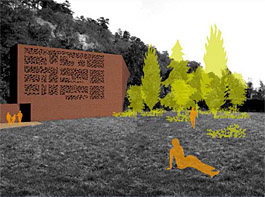
Exhibition of results of the 14th edition of the Xella competition for young architects
Architecture Gallery Brno, May 27 - June 28, 2009, opening on Tuesday, May 26 at 5:30 PM
 |
The demanding yet attractive assignment of the 14th annual XELLA student competition attracted 73 individuals and teams from Czech and Slovak universities focused on architecture, engineering, and art this year. The international jury, composed of renowned Czech and Slovak architects, had a challenging task during their meeting at the Troja castle on March 3 and 4.
The jury decided on the individual proposals in four rounds. Ing. arch. Josef Pleskot was elected as the chairperson. Other jury members included: Vlado Milunić, Ľubomír Králik, Ivan Kubík, Emil Makara, Jarek Veselák, Peter Moravčík, Ľubomír Závodný, and Troja mayor Ing. arch. Tomáš Drdácký. The jurors evaluated not only the architectural design of the buildings but also the philosophical subtext of each proposal and the urban and landscape solutions of the chosen location in the context of the entire area. The ecological footprint of the proposed buildings also played a role in the evaluation of the competition projects.
Winning proposal: Thoughtful work with light, mass, and interior space
According to the jury, the best response to the brief of the 14th annual student competition came from Kateřina Fryzelková from the Faculty of Architecture at the Technical University of Liberec. "Human life is shaped by walls" - the author succinctly captures the essence of her design with a single sentence and relies on an archetypal building element that, in the form of a wall, permeates the entire competition site.
“Convincing integration of the flowing mass of the Human Pavilion into the rocky ridge, which simultaneously provides access to the necessary elevation levels in the zoo. Thoughtful work with light, mass, and interior space. The design maintains a nature-friendly interpretation of landscape modifications, elevating the fence to an equal part of the work. However, there is a need for greater permeability of this wall for the pedestrian visitor. The Ferryman's House as a protruding viewpoint - a window over the river confirms the suitably chosen scale and mutual relationships of all proposed structures," the jury agreed on the winning proposal by Kateřina Fryzelková.
Evaluation criteria and jury composition
The jury decided on individual proposals in four rounds. Ing. arch. Josef Pleskot was elected chairperson. Other jury members were: Vlado Milunić, Ľubomír Králik, Ivan Kubík, Emil Makara, Jarek Veselák, Peter Moravčík, Ľubomír Závodný, and Troja mayor Ing. arch. Tomáš Drdácký. The jurors evaluated not only the architectural design of the buildings but especially the philosophical subtext of each proposal and the urban and landscape solutions of the selected location in the context of the entire area. The ecological footprint of the proposed buildings also played a role in evaluating the competition projects.
The main prize and cash reward of 1500 euros were awarded to Kateřina Fryzelková, a student at the Faculty of Architecture in Liberec, during the official announcement at this year's International Construction Fair in Brno.
List of awarded and recognized works
1st prize: Kateřina Fryzelková, Faculty of Architecture TU Liberec
2nd prize: Nina Holubová, FSv ČVUT Prague
3rd prize: Bc. Lukáš Jedlička, FSv ČVUT Prague
Other awards:
Richtárik Peter, Rožánek Adam, Šranko Richard, FA STU Bratislava
Ševela Dušan, FA STU Bratislava, Šmihula Michal, FA VUT Brno
Tomáš Toegel, FSv ČVUT Prague
You can view the winning projects at www.xella.cz/html/czk/cz/14-rocnik-studentske-souteze-vitezove.php
YTONG is primarily used for the construction of apartment and family houses due to its unique thermal insulation properties, ensuring year-round thermal and humidity comfort. High precision, low weight, speed, and simple masonry technology also make it suitable for the renovation of all types of buildings. The white aerated concrete YTONG is made exclusively from quality natural raw materials, such as siliceous sand, lime, cement, and water. Thus, it is ideal for buildings intended for long-term habitation, including spaces with heightened hygiene requirements.
Xella International GmbH is a leader in the construction materials market both in Europe and worldwide. With approximately 7,400 employees globally, it achieves an annual turnover exceeding 1.2 billion euros. One of the most well-known products of the Xella group is the white aerated concrete brand YTONG. In the Czech Republic, the company Xella CZ operates. Its 350 employees in three Czech plants produce more than 1,000,000 m3 of this precise building material annually. Xella CZ also specializes in other silicate products sold under the brand SILKA. In addition to the brands YTONG and SILKA, the international group’s portfolio includes FERMACELL (gypsum-fiber boards), HEBEL (materials for industrial buildings), AESTUVER (fire-resistant boards), and MULTIPOR (mineral insulating boards). More information about Xella CZ can be found at www.xella.cz, and information about the entire group at www.xella.com.
The English translation is powered by AI tool. Switch to Czech to view the original text source.
0 comments
add comment











